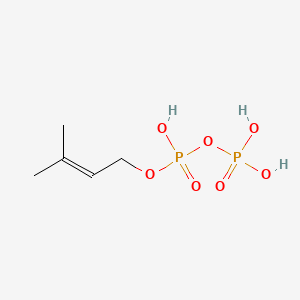| MeSH term | MeSH ID | Detail |
|---|---|---|
| Melanoma | D008545 | 69 associated lipids |
Dimethylallyl pyrophosphate
Dimethylallyl pyrophosphate is a lipid of Prenol Lipids (PR) class. Dimethylallyl pyrophosphate is associated with abnormalities such as Consumption-archaic term for TB and Wiskott-Aldrich Syndrome. The involved functions are known as Anabolism, Biochemical Pathway, Oxidation, Process and Chelating Activity [MoA]. Dimethylallyl pyrophosphate often locates in Chloroplasts, Plastids, chloroplast stroma, Cytosol and Cell membrane. The associated genes with Dimethylallyl pyrophosphate are IRF6 wt Allele and ADRBK1 gene. The related lipids are Sterols.
Cross Reference
Introduction
To understand associated biological information of Dimethylallyl pyrophosphate, we collected biological information of abnormalities, associated pathways, cellular/molecular locations, biological functions, related genes/proteins, lipids and common seen animal/experimental models with organized paragraphs from literatures.
What diseases are associated with Dimethylallyl pyrophosphate?
Dimethylallyl pyrophosphate is suspected in and other diseases in descending order of the highest number of associated sentences.
Related references are mostly published in these journals:
| Disease | Cross reference | Weighted score | Related literature |
|---|
Possible diseases from mapped MeSH terms on references
We collected disease MeSH terms mapped to the references associated with Dimethylallyl pyrophosphate
PubChem Associated disorders and diseases
What pathways are associated with Dimethylallyl pyrophosphate
Lipid pathways are not clear in current pathway databases. We organized associated pathways with Dimethylallyl pyrophosphate through full-text articles, including metabolic pathways or pathways of biological mechanisms.
Related references are published most in these journals:
| Pathway name | Related literatures |
|---|
PubChem Biomolecular Interactions and Pathways
Link to PubChem Biomolecular Interactions and PathwaysWhat cellular locations are associated with Dimethylallyl pyrophosphate?
Visualization in cellular structure
Associated locations are in red color. Not associated locations are in black.
Related references are published most in these journals:
| Location | Cross reference | Weighted score | Related literatures |
|---|
What functions are associated with Dimethylallyl pyrophosphate?
Related references are published most in these journals:
| Function | Cross reference | Weighted score | Related literatures |
|---|
What lipids are associated with Dimethylallyl pyrophosphate?
Related references are published most in these journals:
| Lipid concept | Cross reference | Weighted score | Related literatures |
|---|
What genes are associated with Dimethylallyl pyrophosphate?
Related references are published most in these journals:
| Gene | Cross reference | Weighted score | Related literatures |
|---|
What common seen animal models are associated with Dimethylallyl pyrophosphate?
There are no associated biomedical information in the current reference collection.
NCBI Entrez Crosslinks
All references with Dimethylallyl pyrophosphate
Download all related citations| Authors | Title | Published | Journal | PubMed Link |
|---|---|---|---|---|
| Umeda T et al. | Molecular basis of fosmidomycin's action on the human malaria parasite Plasmodium falciparum. | 2011 | Sci Rep | pmid:22355528 |
| Hussain MS et al. | Current approaches toward production of secondary plant metabolites. | 2012 | J Pharm Bioallied Sci | pmid:22368394 |
| Luo H et al. | Analysis of the transcriptome of Panax notoginseng root uncovers putative triterpene saponin-biosynthetic genes and genetic markers. | 2011 | BMC Genomics | pmid:22369100 |
| Yang ZB et al. | Physiological and molecular analysis of the interaction between aluminium toxicity and drought stress in common bean (Phaseolus vulgaris). | 2012 | J. Exp. Bot. | pmid:22371077 |
| Trowbridge AM et al. | Contribution of various carbon sources toward isoprene biosynthesis in poplar leaves mediated by altered atmospheric CO2 concentrations. | 2012 | PLoS ONE | pmid:22384238 |
| Song AA et al. | Functional expression of an orchid fragrance gene in Lactococcus lactis. | 2012 | Int J Mol Sci | pmid:22408409 |
| Kuzuyama T and Seto H | Two distinct pathways for essential metabolic precursors for isoprenoid biosynthesis. | 2012 | Proc. Jpn. Acad., Ser. B, Phys. Biol. Sci. | pmid:22450534 |
| Jonnalagadda V et al. | Isopentenyl diphosphate isomerase catalyzed reactions in D2O: product release limits the rate of this sluggish enzyme-catalyzed reaction. | 2012 | J. Am. Chem. Soc. | pmid:22471428 |
| Lu XM et al. | Map-based cloning of zb7 encoding an IPP and DMAPP synthase in the MEP pathway of maize. | 2012 | Mol Plant | pmid:22498772 |
| Berthelot K et al. | Isopentenyl diphosphate isomerase: A checkpoint to isoprenoid biosynthesis. | 2012 | Biochimie | pmid:22503704 |
| Nakatani H et al. | Substrate-induced change in the quaternary structure of type 2 isopentenyl diphosphate isomerase from Sulfolobus shibatae. | 2012 | J. Bacteriol. | pmid:22505674 |
| Yang J et al. | Enhancing production of bio-isoprene using hybrid MVA pathway and isoprene synthase in E. coli. | 2012 | PLoS ONE | pmid:22558074 |
| Fatima T et al. | Fatty acid composition of developing sea buckthorn (Hippophae rhamnoides L.) berry and the transcriptome of the mature seed. | 2012 | PLoS ONE | pmid:22558083 |
| Tidten-Luksch N et al. | IspE inhibitors identified by a combination of in silico and in vitro high-throughput screening. | 2012 | PLoS ONE | pmid:22563402 |
| Gonzales-Vigil E et al. | Evolution of TPS20-related terpene synthases influences chemical diversity in the glandular trichomes of the wild tomato relative Solanum habrochaites. | 2012 | Plant J. | pmid:22563774 |
| Wollinsky B et al. | Prenylation at the indole ring leads to a significant increase of cytotoxicity of tryptophan-containing cyclic dipeptides. | 2012 | Bioorg. Med. Chem. Lett. | pmid:22617493 |
| pmid:22623294 | ||||
| pmid:22623313 | ||||
| pmid:22642693 | ||||
| Xu W et al. | A closer look at the spectroscopic properties of possible reaction intermediates in wild-type and mutant (E)-4-hydroxy-3-methylbut-2-enyl diphosphate reductase. | 2012 | Biochemistry | pmid:22646150 |
